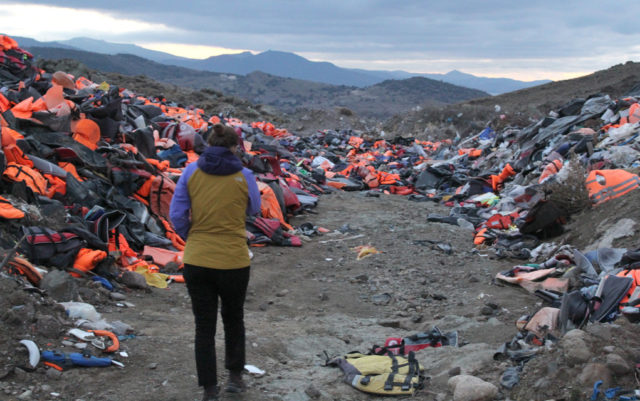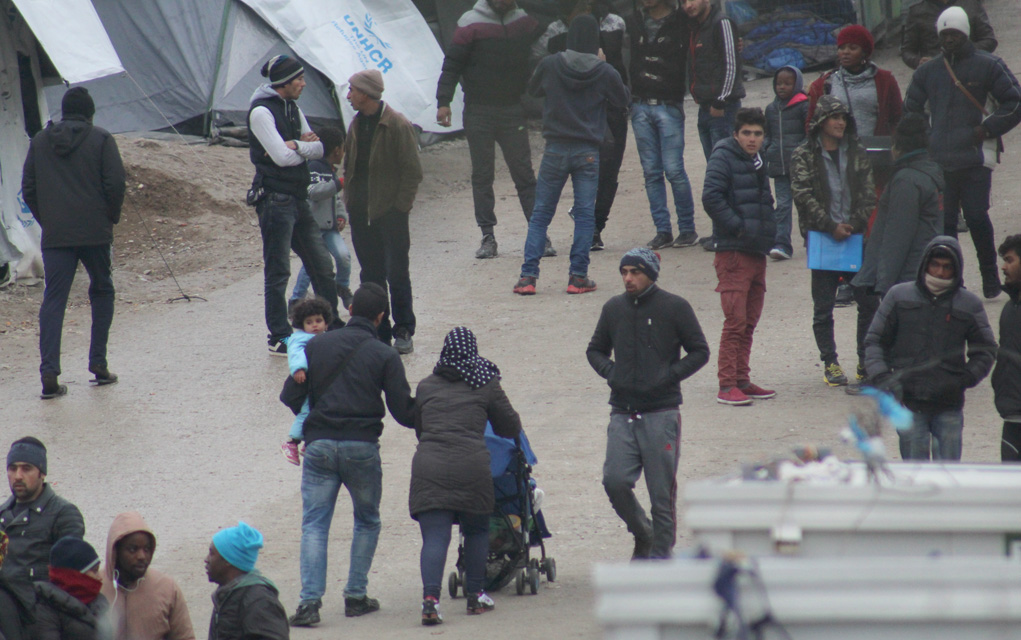
“My friends, welcome to Lesbos — now you are going to Moria.”
The blue bus with iron grates on its windows sits perched on a patch of dirt next to the United Nations High Commissioner for Refugees (UNHCR) staging area for newly landed refugees. The view of the clear sea, white-brick village and palm fronds would be akin to paradise given different circumstances. But now, as a group of sleepy volunteers from the few NGOs left on the island watch on in the early morning sun, refugees from Africa and the Middle East are loaded onto the bus with the few possessions they still have — most still sopping wet — to be taken to the permanent holding camp on the island.
The tumult is over at this point. The boat has been guided safely to shore, the medical cases have been treated — sometimes only a hurt wrist, sometimes gangrene or frostbite; the variation in urgency can be extreme. Tea has been distributed, and those soaked through have been, hopefully, given a change of clothes. The long wait has start-ed. After a treacherous 4-mile crossing from Izmir or Avylik to Skala Sikimineas, these people escaping war and terror are about to spend months in the process to gain asylum.
Moria is situated an hour away from the north shore and 7 kilometers from the main port of Mytilene. The road is bumpy and mountainous, passing through scrub-brush and goat pastures, over hills as old as civilization. Brick edifices covered by moss hang around the cliff sides with-out the sterile plaques of museums to classify their age, leaving you wondering who built them and how long they have been standing.
This is only seen, of course, by the ones who survived the crossing. A UNHCR report states that the refugees crossing the sea have dropped by 99 percent since the EU-Turkey deal in March 2016, but the rate of deaths has gone up to one in 393 people.
The camp that greets the refugees is stark, surrounded by heavy chain-link fences and covered in barbed wire that looks more like a prison or a World War II internment camp than a home. Up until February 2017, when four people died from the storms that hit in the winter, the men and women were living in tents, sometimes four or five men to a space. Now they are living in ISO-boxes, semi-permanent structures made out of plastic siding. Only a few tents still dot the hillside next to the road. In order to move on from the camp situated next to the small island village, first a refugee must process their asylum paperwork, and then the EU has to deem their story credible enough to warrant refuge. People wait months before they can even think about moving on to Athens.
A hazy future awaits them in their next port of call. Athens is still grappling with unemployment, a figure report-ed at 23 per-cent, and a massive debt that has led to equally massive austerity measures by the European Union. The lucky ones integrate into squats, and get the chance to thrive in a new community. The rest are relegated to different camps or forced to survive on the streets.

Some family members are separated for an interminable period of time. Ameer, a tall, slender Syrian man that used to operate a food cart outside of the camp, told me he had waited six months for his paper-work to be processed, to get the OK before moving onto Athens. But when he found his brother in the camp he decided to stay longer and wait so they could travel together. They had been apart for over two years after his brother was caught by ISIS, and he had feared his brother had died. When they met again in the mud-streaked camp by accident, they cried tears of joy.
Moria is one of the last standing camps on Lesbos, and, like the ruins of brick that dot the hillside, it is but a remnant of a more chaotic time. The newspapers, and the numbers, tell us that the refugee crisis is over. The hundreds of thousands that had crossed in the previous year has been reduced to a sparse tens of thousands. The screaming women and children washing ashore no longer dominate headlines.
In a few years, tourism will return to the island. Rich pensioners and young college kids will now share the hotels housing the last of the men and women who survived the major refugee surge in 2015. They will never know each other’s names, or the names and the faces of those who landed next to the bronze hills of Eftalou, or climbed the craggy rocks near Tsonia and Klio looking for warmth and safety. The tracers are disappearing. Lighthouse Relief’s eco-project has done a fine job removing the unsightly black rubber from the busted dinghies off the shoreline, and the fiber glass vessels that once housed a hundred souls blend in with the innumerable fishing boats of the natives.
But the men and women that crossed the sea, the children who lost friends, brothers, mothers and neighbors will not forget. Their eyes will speak of the tragedy they have survived, how they were received and what has been done to them.














